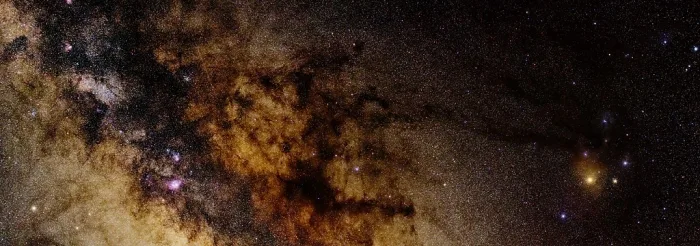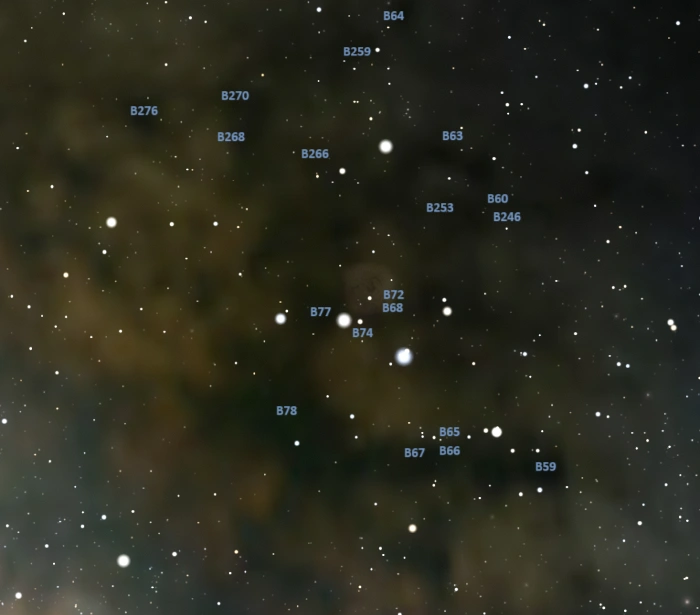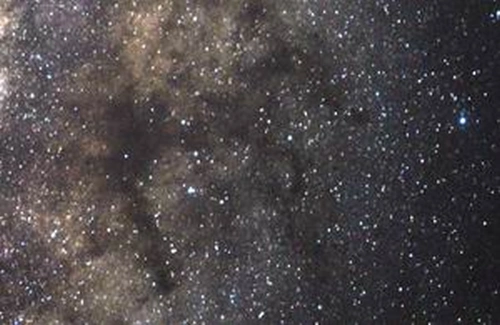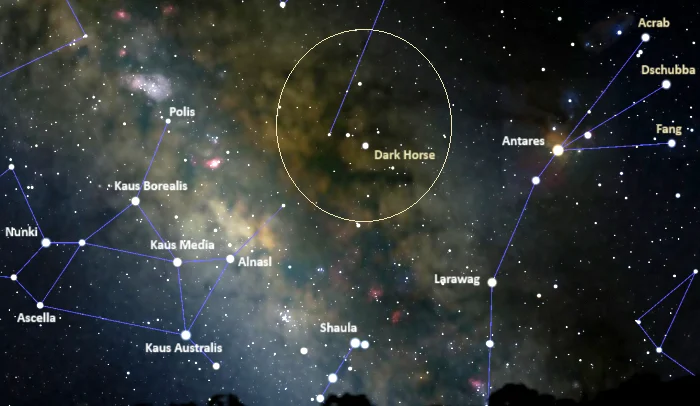The Dark Horse Nebula is a large dark nebula complex located in the constellation Ophiuchus. Stretching across an area of 10 degrees, it is one of the most prominent groups of dark nebulae in the night sky. Also known as the Prancing Horse or Great Dark Horse Nebula, the vast cloud of interstellar dust absorbs the light of part of the Milky Way galaxy’s upper central bulge. It is visible from locations without light pollution on a very clear, dark night.
The Dark Horse consists of several dark nebulae that form a shape similar to that of a side silhouette of a horse. With an apparent size of 10 by 10 degrees, the entire dark nebula complex is larger than the southern Coalsack Nebula, which stretches across an area of 7 by 5 degrees in the constellations Crux, Centaurus and Musca.
The dark absorption nebulae that form the Great Dark Horse – the Pipe Nebula, the Snake Nebula, and Barnard 68, among others – are contrasted against the stars and star clouds that glow in the background. The horse’s head is oriented towards the north and its legs towards the west. The entire Dark Horse appears in the rich field of the Milky Way’s bright band.

Dark Horse Nebula, image credit: Flickr Commons/Hypatia Alexandria (CC BY 2.0)
The Pipe Nebula, which forms the horse’s rump and hind legs, itself has several designations in the Barnard Catalogue of dark nebulae: Barnard 59, Barnard 65, Barnard 66, Barnard 67, and Barnard 78. It is a large, dark dust lane that bears a resemblance to a smoking pipe. It lies 600 to 700 light-years away.
The Pipe Nebula consists of two main parts. The Pipe Stem includes the nebulae Barnard 59, 65, 66, and 67. B59 is popularly known as the Sink Hole. With an opacity of 6, it is the darker portion of the Pipe. B59 marks the horse’s hoof and the other three nebulae its leg.
The Bowl of the Pipe is catalogued as Barnard 78 and is slightly less dense, with an opacity of 5. It forms the upper rump of the Dark Horse. The Pipe Stem is 300 by 60 arcminutes across, and the Bowl has an apparent size of 200 by 140 arcminutes.
The Snake Nebula is a smaller, S-shaped dark nebula that emerges from Barnard 77. The nebula lies 650 light years away. It is catalogued as Barnard 72. It appears at the northwestern edge of the Bowl of the Pipe. The nebula stretches across an area between 2 and 3 arcminutes thick and 6 arcminutes long. It can be seen in a small telescope in good conditions.
Barnard 68 is a small dark patch next to B72. It has an opacity of 6 and is known as the Ink Spot Nebula. It is about half a light-year across and lies 407 light years away.
The dark nebulae Barnard 74 and Barnard 77 complete the horse’s main body. Barnard 63 outlines its front prancing leg and the nebulae Barnard 60, Barnard 246 and Barnard 253 its other front leg.

Map of the Dark Horse Nebula, image: Stellarium
The complex of nebulae that form the horse’s head include Barnard 64, Barnard 259, Barnard 266, Barnard 268, and Barnard 270. Barnard 276 marks the head of the rider.
The Dark Horse Nebula is part of the much larger Great Rift, a dark band of interstellar clouds of dust that obscures the centre and most radial sectors of our galaxy’s bright band. Popularly known as the Dark Rift or Dark River, the Great Rift appears as a dark lane that stretches across a third of the Milky Way’s band and divides it vertically. It starts at the Northern Coalsack Nebula in the constellation Cygnus (the Swan), obscures the view of the Galactic centre in Sagittarius, and ends in Centaurus in the far southern sky.
The clouds of cosmic dust that form the Great Dark Horse obstruct the view of millions of stars and deep sky objects in the Milky Way. They lie between the solar system near the inner edge of the Milky Way’s Orion Arm and the next inward arm, the Sagittarius Arm. The clouds in the radial sector of the Milky Way span a diameter approximately 2,600 to 3,300 light-years from earth. They contain an estimated 1 million solar masses of dust and plasma.

Dark Horse Nebula, image: Wikimedia Commons/Ngc3532 (PD)
Location
The Dark Horse Nebula lies in the southern part of Ophiuchus (the Serpent Bearer), near the border with the brighter Sagittarius (the Archer) and Scorpius (the Scorpion). It appears between Polis (Mu Sagittarii) and Kaus Borealis (Lambda Sagittarii) in Sagittarius and the Scorpion’s claws, marked by Acrab (Beta Scorpii), Dschubba (Delta Scorpii), and Fang (Pi Scorpii).
Many bright star clusters and nebulae appear in the region of the Dark Horse Nebula. The open cluster Messier 23 and globular cluster NGC 6440 appear near the rider’s head. The globular clusters Messier 9 and NGC 6356 lie near the horse’s head, close to the bright Sabik (Eta Ophiuchi).
The globular cluster NGC 6401 appears near the rump, and the Little Ghost Nebula (NGC 6369) appears east and a little north of B77 in the horse’s body. The globular cluster NGC 6325 lies near the horse’s front foot, and NGC 6355 appears east of B65 in the horse’s rear leg. The globulars Messier 19, NGC 6293 and NGC 6316 lie close to the rear hoof.

Location of the Dark Horse Nebula, image: Stellarium
The Dark Horse Nebula and other deep sky objects in Ophiuchus are best seen during the month of July, when the constellation appears high above the horizon in the early evening. The Great Dark Horse is too large to fit into a single binocular field of view, but its components can be observed in small binoculars on a very clear, dark night.
Dark Horse Nebula
| Constellation | Ophiuchus |
| Object type | Dark nebula |
| Right ascension | 17h 21m |
| Declination | −21° 07′ |
| Apparent size | 10° × 10° |
| Names and designations | Dark Horse Nebula, Great Dark Horse, Prancing Horse Nebula |